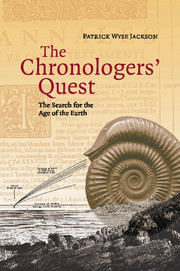Book contents
- Frontmatter
- Contents
- List of illustrations
- List of tables
- Preface
- Acknowledgements
- 1 The ancients: early chronologies
- 2 Biblical calculations
- 3 Models of Aristotelian infinity and sacred theories of the Earth
- 4 Falling stones, salty oceans, and evaporating waters: early empirical measurements of the age of the Earth
- 5 Thinking in layers: early ideas in stratigraphy
- 6 An infinite and cyclical Earth and religious orthodoxy
- 7 The cooling Earth
- 8 Stratigraphical laws, uniformitarianism and the development of the geological column
- 9 ‘Formed stones’ and their subsequent role in biostratigraphy and evolutionary theory
- 10 The hour-glass of accumulated or denuded sediments
- 11 Thermodynamics and the cooling Earth revisited
- 12 Oceanic salination reconsidered
- 13 Radioactivity: invisible geochronometers
- 14 The Universal problem and Duck Soup
- Bibliography
- Index
1 - The ancients: early chronologies
Published online by Cambridge University Press: 02 December 2009
- Frontmatter
- Contents
- List of illustrations
- List of tables
- Preface
- Acknowledgements
- 1 The ancients: early chronologies
- 2 Biblical calculations
- 3 Models of Aristotelian infinity and sacred theories of the Earth
- 4 Falling stones, salty oceans, and evaporating waters: early empirical measurements of the age of the Earth
- 5 Thinking in layers: early ideas in stratigraphy
- 6 An infinite and cyclical Earth and religious orthodoxy
- 7 The cooling Earth
- 8 Stratigraphical laws, uniformitarianism and the development of the geological column
- 9 ‘Formed stones’ and their subsequent role in biostratigraphy and evolutionary theory
- 10 The hour-glass of accumulated or denuded sediments
- 11 Thermodynamics and the cooling Earth revisited
- 12 Oceanic salination reconsidered
- 13 Radioactivity: invisible geochronometers
- 14 The Universal problem and Duck Soup
- Bibliography
- Index
Summary
Creation, be it of the Universe or the Earth, has been a subject of fascination for centuries. Through the ages, philosophers and latterly scientists have struggled to come up with a logical explanation of how the Earth and the Universe came to be. Allied to this has been the question: when did creation take place?
In many cases early philosophers and thinkers made no distinction between the date of formation of the Earth, the Universe or indeed the appearance of mankind. In many mythologies no actual dates are given. Creation myths, or more correctly beliefs, as one would expect, are frequently closely related to the experiences exerted on the civilisations that propounded them. Thus among peoples of the northern hemisphere great emphasis is placed on ice, frost and cold climatic conditions, whereas the Persians and Egyptians set great store, respectively, by the Tigris and Euphrates, and by the Nile, and their essential life-giving properties. These beliefs allowed man to grasp an understanding of his environment and the planet on which he lived. The annual, seasonal, diurnal cycles were seen to be recurring, and these events were explained through the adoption of higher life-forces or gods.
In some civilisations the Earth and Universe are seen as everlasting, while in others they have a definite time-progression from birth to eventual death. Nearly 2,000 years ago the Roman poet, writer and philosopher Carus Titus Lucretius (c. 95–55 bc) published De rerum natura just two years before his suicide.
- Type
- Chapter
- Information
- The Chronologers' QuestThe Search for the Age of the Earth, pp. 1 - 12Publisher: Cambridge University PressPrint publication year: 2006



